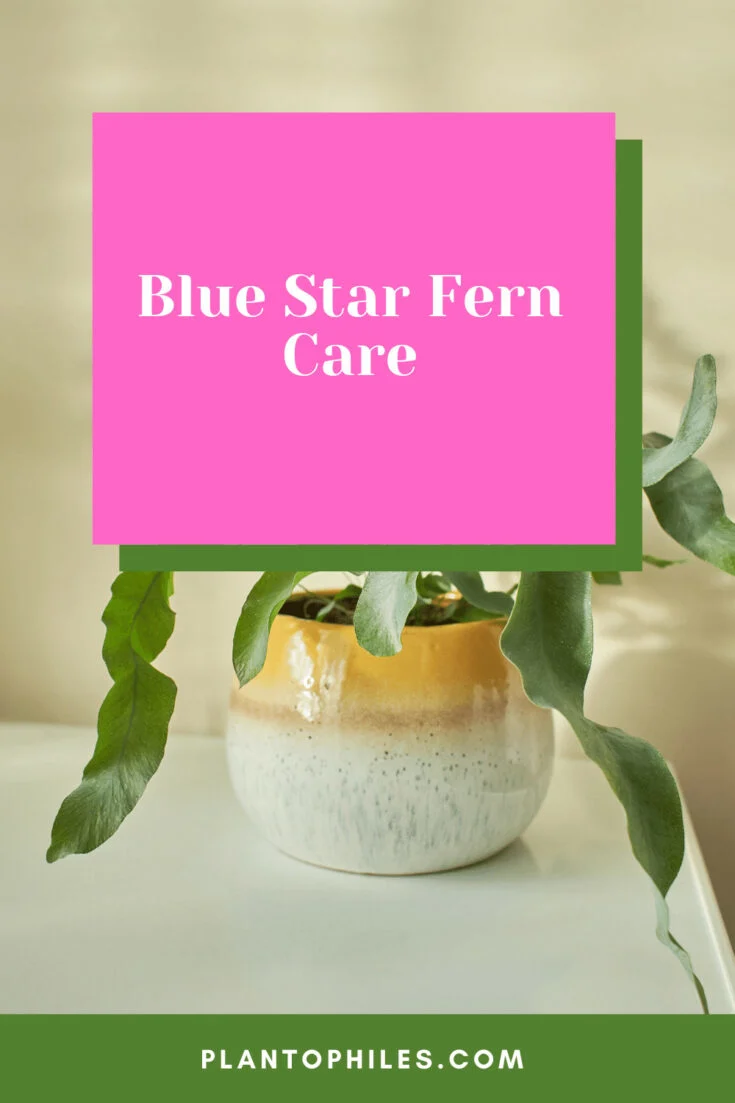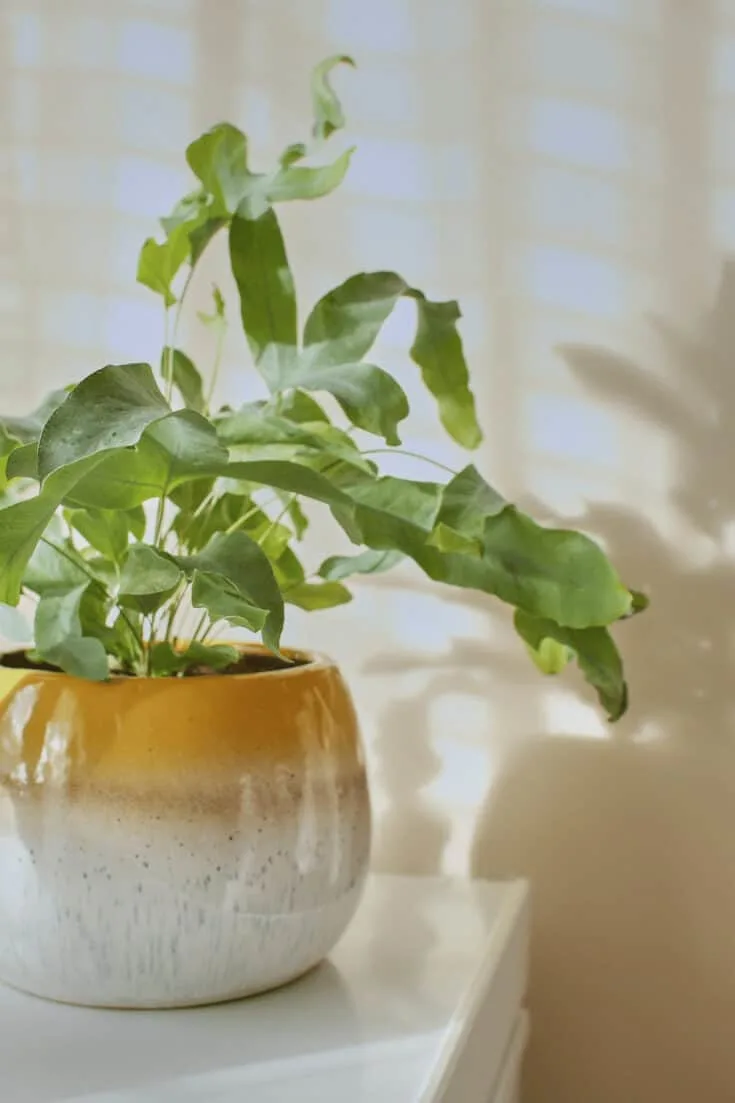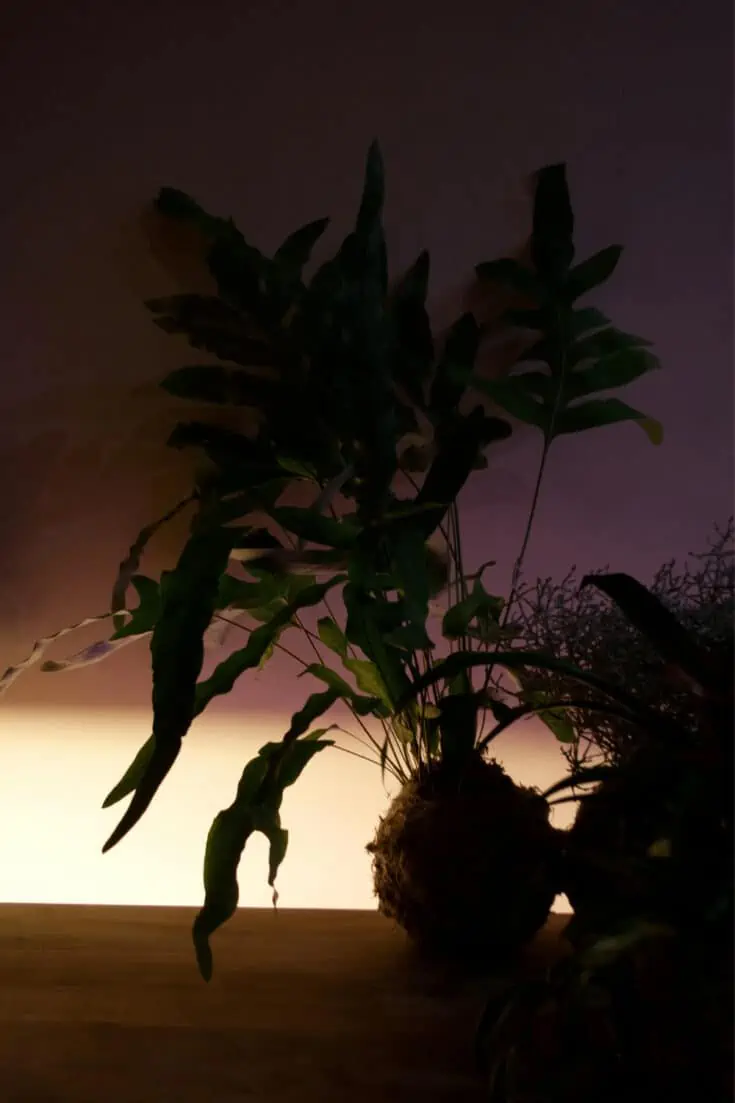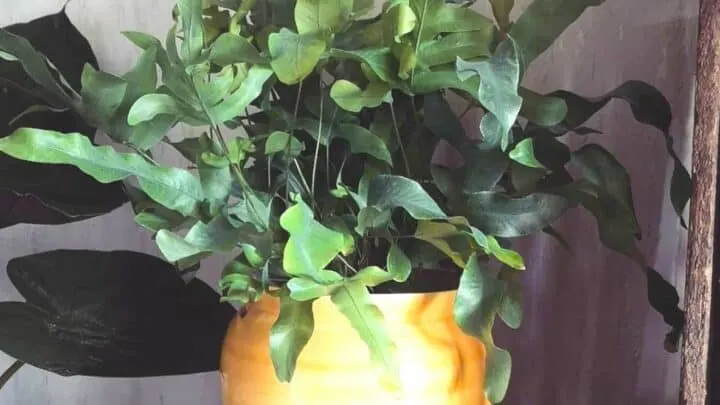Phlebodium aureum, commonly known as Blue Star Fern, is a funky little plant with lots of personality.
Originally found growing on trees in the high parts of the forest canopy, this epiphytic fern has found a permanent place inside homes as a trusty houseplant.
The word aureum means yellow and refers to the fuzzy orange rhizome roots that poke out from the soil.
These interesting roots are hidden behind a beautiful curtain of light greenish-blue foliage.
Their quirky appearance and moderately easy care (especially compared to other ferns) make the Blue Star Fern a must-have.
Blue Star Fern Care
To care for a Blue Star Fern place it in a well-lit area away from direct light and a temperature between 54-78°F (12-26°C). Plant them in a well-draining soil mix consisting of vermiculite and perlite and water when the top 2” (5cm) of soil dry out. Humidity around 75% is optimal and fertilized monthly in spring and summer using a diluted fertilizer to 1/4 strength.

Blue Star Fern Care
Table of Contents
Blue Star Fern Care Guide
Soil
Grow your Blue Star Fern in well-draining soil using perlite and vermiculite, which will stay moist but not waterlogged.
As epiphytes, Blue Star Ferns typically grow on the surface of other plants and source their nutrient and moisture needs from the buildup around it.
Because of these growing habits, it doesn’t do super well in standard potting soil.
You can amend a standard potting soil by adding perlite or vermiculite to increase drainage and compost to retain moisture.
Combining equal parts of each will give you a well-draining, yet moisture-retaining soil that will be perfect for your fern.
If you’re not one to make you’re own potting soil, look out for a bagged mixed labeled as well-draining.
Watering
Keep the soil for Blue Star Fern moist and water weekly once the top 2” of soil (5cm) almost dry out.
Blue Star Ferns grow naturally in tropical areas, making them accustomed to high humidity and moist soil.
To replicate tropical conditions, keep the soil moist, but not wet, by watering weekly.
Water your plant when the top two inches of soil get dry. You can check this by poking your finger into the surface.
Water slowly from the side and pour out the water from the dish underneath so the roots don’t sit in water.
Blue Star Ferns don’t like to get their leaves or fuzzy orange rhizomes wet.
So when you’re watering, gently push the leaves away and water from the side.
You can, however, gently mist them occasionally if the humidity is too low.
They also don’t like the soil to be wet and soggy.
It will suffer if excess water isn’t able to drain out of the pot, so it’s essential to ensure drainage holes and a proper potting mix.
If your Blue Star Fern isn’t growing much, it could be a sign of overwatering so check the soil and adjust the watering schedule until you find what works.
Should your Blue Star Fern dry out, don’t be sad, it can be recovered! Water it well and trim off any damaged leaves.
Moist soil and trim will surely incentivize new growth. You’ll notice improvement within a couple of weeks.
Light
Place your Blue Star Fern in bright, indirect sunlight.
Although they are more tolerant than other ferns to varying levels of brightness, harsh direct sunlight will cause damage.
Direct sunlight in the morning or late afternoon should be ok, but the bright midday sun will burn the leaves.
If you have it placed by a window, surround it with other plants to ‘hide’ it from any direct rays.
If you experience burned leaves, simply adjust your plants’ location and trim off the damaged fronds.
Your Blue Star Fern will show you it’s not getting enough light by dropping its leaves.
Foliage will become sad and droopy looking before this so make sure to move it to a sunnier spot if you notice this.
Temperature
The perfect temperature for a Blue Star Fern is between 54-78°F (12-26°C).
Luckily for you, this is within the range of most home temperatures. If you are comfortable in your home during the winter, so are your houseplants.
Just make sure to avoid exposing your fern to sudden temperature changes. Also, keep it away from air vents like air conditioners and heaters.
Humidity
Blue Star Ferns like humid environments with an ambient humidity of about 75%.
They’re fabulous for bathrooms that get some natural light.
If you need to create a humid environment in the rest of the house, place the pot on a pebble tray partially filled with water or put your fern near other plants.
Another option is to keep a spray bottle close and periodically mist the foliage. Don’t get it too wet though!

A Blue Star Fern likes very high humidity around 75%
Fertilizer
For Blue Star Fern use a diluted balanced fertilizer to 1/4 strength once a month in spring and summer.
Ferns don’t need much fertilizing and will actually be damaged from overfeeding.
If you do want to fertilize your fern, use a diluted balanced fertilizer.
Apply it once a month during the growing between spring and summer.
Repotting
Blue Star Ferns grow fairly quickly and will need to be repotted every year or when they get too big for their pot.
Check their roots to see if they’re overgrown and if the soil has become loose, it might be time to repot.
Make sure to water the soil 24 hours before repotting to avoid transplant shock. Follow the soil requirements and continue the same care practices highlighted in this article.
Pruning
Cut away any brown or wilted foliage. Pruning will encourage new growth and keep your plant looking tidy.
Whenever you prune your houseplants, make sure to clean and disinfect the scissors beforehand and between different plants.
This will prevent the spread of bacteria and will help you keep your plants disease-free.
Propagating
Propagate a Blue Star Fern by diving the root system or cutting off a piece of rhizome while repotting it.
You can also grow a new plant from the spores, but please refer to the section on blooms.
To propagate by division start by carefully removing the fern from its original spot and gently shaking out the soil from the roots.
Then choose a section of the plant that have both roots, rhizomes, and foliage. Separate these from the main plant and repot them in a separate container.
To propagate by cutting, also start by removing the plant from the pot. Next, cut a piece of rhizome about 3” long (8cm) by using a disinfected tool.
Choose a piece that has several leaf segments coming off of it. Place the separated rhizome into a separate pot, but don’t cover the roots entirely. Finish up by repotting the original plant.
When propagating via either of these methods make sure your plant is happy and healthy, to begin with.
Propagating a struggling plant will have a much lower success rate.

A Blue Star Fern can be propagated by diving the root system or cutting off a piece of rhizome
Blooms
Ferns, including the Blue Star Fern, don’t produce blooms.
Instead, they reproduce through spores on the underside of their leaves.
When the leaves begin to dry out, you’ll notice that the orange spores under the leaves will also dry out and turn brown.
Reproducing a fern from spores is a lot like starting a plant from a seed. Start by picking out the spore using a toothpick.
If it doesn’t want to detach, cut the leaf around it.
Then, press the spore into a seed starting soil mix and leave it to germinate.
Leave the spore on top of the soil and don’t cover it.
Cover the spore container with a plastic bag to create a sort of homemade greenhouse and mist inside with a spray bottle every few days.
Make sure the soil also stays moist by bottom-watering a little bit.
It should take about two months for fern spores to germinate. Make sure to monitor moisture levels so the soil never dries out and keep an eye out for any sign of life.
Don’t give up until well after five months since it can sometimes take a long time.
If you don’t have the patience or attention to start a new plant from spores, I recommend multiplying via root division.
View this post on Instagram
Blue Star Fern
In general, ferns can be challenging plants to care for. They are very sensitive to light and humidity and will quickly show signs of distress.
The Blue Star Fern, however, is a great one to start with because they are quite tolerant and will bounce back more easily than other ferns.
Blue Star Ferns grow about a meter high and the foliage isn’t what we commonly associate with intensely green and fluffy looking ferns.
The fronds look like blue-green lobed leaves, that sometimes show off some silver and grey coloring.
Looking under the leaves will reveal bright-organge clusters of sporangia that hold the fern’s spores.
From terrariums to pots, your Blue Star Fern will adapt to a broad range of growing conditions. It is a much more forgiving plant than other ferns.
So if you’re new to ferns or just want a low-maintenance plant, this mighty plant is a great choice.
Before you bring your new plant home, make sure to give this Blue Star Fern care guide well to learn everything you need to know for your plant to thrive.
Common Problems with Blue Star Fern
As far as ferns go, Phlebodium aureum is very low maintenance.
The biggest problems you might encounter are rotting roots from excess moisture and unflattering yellow foliage from incorrect watering or exposure to sunlight.
Overwatering
The most common and most difficult to solve issue with Blue Star Ferns is an excess of water.
If the soil isn’t able to drain excess water, the pot doesn’t have a drainage hole, or you’re watering too frequently the roots will start to rot.
Rotting roots will eventually kill the whole plant, so make sure to deal with this as soon as you can.
If you notice your plant isn’t growing much, put your finger in the soil. If it’s quite wet (and you haven’t just watered it), that’s a sure sign that the roots are waterlogged.
To correct this issue, repot your plant to confirm the drainage hole is clear and add more perlite or vermiculite to the soil mix.
Once you repot, pay close attention to the humidity over the soil over the next week and only water when the top has dried out.
Incorrect Light
With ferns, it’s easy for them to get too little or too much light. Blue Star Ferns, specifically, prefer bright indirect light.
Keeping them in a brightly lit room but away from the window is a great place for them.
Too much direct sunlight will burn and crisp up the leaves.
Should this happen, find a place to keep your fern that doesn’t receive direct sunlight and trim off the damaged areas.
It will bounce back and grow back new leaves quickly.
Too little light will result in sad-looking, droopy leaves.
Signs of low light are harder to notice, but when your Blue Star Fern starts losing leaves, it’s definitely time to move it to a sunnier spot.
Tips for Growing Blue Star Fern
To set your Blue Star Fern up for success follow these basic principles
- Plant it in pot with drainage holes using well-draining soil.
- Only water when the top has dried out a bit, about once a week.
- Keep in a well-lit room away from direct sunlight.
- Undergo regular maintenance like pruning, repotting, and diving to keep your fern looking great.
Lastly, pay attention to your plant.
Each plant is a little different and each home is a little different, so keep adjusting until you find what works and don’t give up.
Frequently Asked Questions about Blue Star Fern
Can I grow a Blue Star Fern from seeds?
Ferns don’t produce flowers nor seeds. You can propagate your Blue Star Fern by dividing the roots or start a new plant from the spores. Spores are a fern’s version of seeds, but instead of growing from flowers, they grow on the underside of leaves.
Are Blue Star Ferns edible?
Ferns are not edible and most have an enzyme called thiaminase that steals vitamin B complex from the body. It’s best to keep your Blue Star Fern in its pot and away from your place.
Is it safe to grow a Blue Star Fern with pets around?
Yes! Unlike other houseplants, Blue Star Ferns are perfectly safe if your furry friend decides to take a nibble. They’re not particularly delicious so I wouldn’t worry about it become habitual, but this is a fern you can have around curious eaters.
Conclusion About Blue Star Fern Care
Plants will show you how they are feeling and ferns are particularly sensitive.
If your Blue Star Fern has brown, dry fronds it can be a sign of underwatering, excessive sunlight, or exposure to dry air.
With time you will get to know the specific preferences of your Blue Star Fern and the conditions it likes best.

Daniel has been a plant enthusiast for over 20 years. He owns hundreds of houseplants and prepares for the chili growing seasons yearly with great anticipation. His favorite plants are plant species in the Araceae family, such as Monstera, Philodendron, and Anthurium. He also loves gardening and is growing hot peppers, tomatoes, and many more vegetables.


